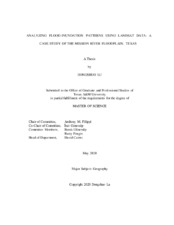| dc.description.abstract | Flood inundation is widely acknowledged as a significant factor in the healthy functioning of floodplains. However, increasing human activities, particularly over the past several decades, have threatened the original river systems. Analyzing inundation patterns of floodplains can provide insights into the planning for unregulated floodplains, or restoration strategies for destroyed floodplain ecosystems. A case study was conducted to examine the inundation patterns of the Mission River Floodplain (MRF) in both the spatial and temporal dimensions. In this study, we proposed a weighted approach to derive the flood inundation frequency and examined its relationship to the coastal ecosystems. Exceedance probabilities of the Mission River were calculated based on daily flow from water year 1939 to 2018. Then, flood-inundation information was extracted from 135 multitemporal Landsat satellite images acquired between 1984 and 2018 to create an inundation frequency map, with weights derived from the exceedance probabilities. The inundation frequency map was jointly analyzed with several factors to determine the spatial patterns of inundation. Results reveal a strong relationship between inundation frequency and land cover, as well as soil types. Inundation frequency exhibited a stronger relationship with elevation than slope. To examine the temporal patterns of inundation, a multiple linear regression model for inundation percentage was generated. Result reveals a strong relationship between inundation percentage and discharge or precipitation. Longterm inundation dynamics were determined based on historical discharge and precipitation records. Understanding the spatial and temporal patterns of flood inundation is essential for effective ecological restoration and management of coastal riverine ecosystems, and thus, for achieving their sustainability in the presence of the changing nature of flood events. | en |


